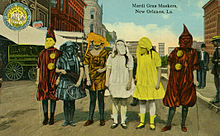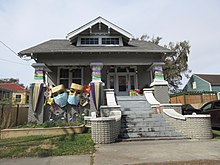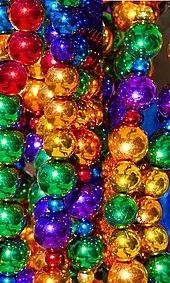Mardi Gras in New Orleans
Club, or Krewe, balls start soon after, though most are extremely private, with their Kings and Queens coming from wealthy old families and their courts consisting of the season's debutantes.
Walking parades - most notably the Krewe du Vieux and 'tit Rex - also take place downtown in the Faubourg Marigny and Spanish Quarter in the weekends preceding Mardi Gras Day.
Men and boys, women and girls, bond and free, white and black, yellow and brown, exert themselves to invent and appear in grotesque, quizzical, diabolic, horrible, strange masks, and disguises.
Human bodies are seen with heads of beasts and birds, beasts and birds with human heads; demi-beasts, demi-fishes, snakes' heads and bodies with arms of apes; man-bats from the moon; mermaids; satyrs, beggars, monks, and robbers parade and march on foot, on horseback, in wagons, carts, coaches, cars, &c., in rich confusion, up and down the streets, wildly shouting, singing, laughing, drumming, fiddling, fifeing, and all throwing flour broadcast as they wend their reckless way.In 1856, 21 businessmen gathered at a club room in the French Quarter to organize a secret society to observe Mardi Gras with a formal parade.
Guardsmen prevented crimes against persons or property but made no attempt to enforce laws regulating morality or drug use; for these reasons, some in the French Quarter bohemian community recall 1979 as the city's best Mardi Gras ever.
[9] Shortly after the law was passed, the city demanded that these krewes provide them with membership lists, contrary to the long-standing traditions of secrecy and the distinctly private nature of these groups.
Today, New Orleans krewes operate under a business structure; membership is open to anyone who pays dues, and any member can have a place on a parade float.
The 2006 New Orleans Carnival schedule included the Krewe du Vieux on its traditional route through Marigny and the French Quarter on February 11, the Saturday two weekends before Mardi Gras.
Following the incident during the Nyx parade, there were calls for New Orleans officials to address safety issues with these floats (including outright bans, or requiring the gaps to be filled in using a barrier).
[12][13][14] Unknown to the participants and local leaders at the time, the 2020 Carnival season (with parades running from January through Mardi Gras Day on February 25) coincided with increasing spread of coronavirus disease 2019 (COVID-19) in the United States as part of what was then classified as a global epidemic.
Louisiana State University (LSU) associate professor Susanne Straif-Bourgeoi suggested that the rapid spread may have been aided by Mardi Gras festivities.
Mayor LaToya Cantrell stated that she would have cancelled Mardi Gras festivities had she been provided with sufficient warning by the federal government, and criticized the Trump administration for downplaying the threat.
[15][21] Amid continued spread of COVID-19 across the country, in early-November 2020 Cantrell stated that celebrations in 2021 would have to be "something different", as Mardi Gras could not be canceled outright since it is a religious observance.
[25][26] Other krewes subsequently announced that they would cancel their in-person balls, including Endymion and Rex (who therefore did not name a King and Queen of Mardi Gras for the first time since World War II).
A Facebook group known as the "Krewe of House Floats" shared photos of the homes and provided maps, recording participation in the movement in both New Orleans and abroad, including at least one in Australia.
[34][35] On January 6, 2022, Mayor Cantrell stated during a kickoff event that "without a doubt, we will have Mardi Gras in 2022", citing high COVID-19 vaccination rates, and customarily asked residents to "do everything that we know is necessary to keep our people safe."
[33] The city announced COVID-19 protocols for Mardi Gras 2022 in February 2022, which requires, at a minimum, all participants in a parade (including marchers, performers, and those a riding a float) to present proof of vaccination or a negative COVID-19 test from within the past 72 hours.
Despite the presence of Omicron variant, city health director Jennifer Avegno stated that she was confident Mardi Gras could be conducted in a more normal fashion over 2021.
[45] A number of other groups such as the Phunny Phorty Phellows, La Société Pas Si Secrète Des Champs-Élysées and the Krewe de Jeanne D'Arc have more recently begun to stage events on Epiphany as well.
The celebrations begin early on Mardi Gras Day, which can fall on any Tuesday between February 3 and March 9 (depending on the date of Easter, and thus of Ash Wednesday).
Banks are closed, and some businesses and other places with security concerns (such as convenience stores) post signs asking people to remove their masks before entering.
[51] In addition to the toxicity of tons of plastic, eye injuries from Mardi Gras parade throws are commonplace, and more severe injuries—such as a fractured skull in an infant struck by a coconut—have also been known to occur.
After their exclusion from Rex, in 1909 Black Creole and other African American New Orleanians, led by a mutual aid group known as "The Tramps", adorned William Storey with a tin can crown and banana stalk scepter and named him King Zulu.
Many people view flambeau-carrying as a kind of performance art – a valid assessment given the wild gyrations and flourishes displayed by experienced flambeau carriers in a parade.
In the year 2000, a local electronics engineer, Willie Clark, introduced an upgraded version of the classic, naming them Mardi Gras Coconuts.
Aguardiente de Ojén (es), or simply "ojen" ("OH-hen") as it is known in English, is a Spanish anisette traditionally consumed during the New Orleans Mardi Gras festivities.
[56] In Ojén, the original Spanish town where it is produced, production stopped for years, but it started again in early 2014 by means of the distillery company Dominique Mertens Impex.
[60][61] Wearing less clothing than considered decent in other contexts during Mardi Gras has been documented since 1889, when the Times-Democrat decried the "degree of immodesty exhibited by nearly all female masqueraders seen on the streets."
The practice of exposing female breasts in exchange for Mardi Gras beads, however, was mostly limited to tourists in the upper Bourbon Street area.
In the last decades of the 20th century, the rise in producing commercial videotapes catering to voyeurs helped encourage a tradition of women baring their breasts in exchange for beads and trinkets.









